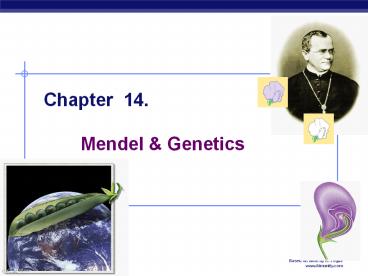Chapter 14. Mendel - PowerPoint PPT Presentation
1 / 31
Title:
Chapter 14. Mendel
Description:
diploid organism. inherits 2 sets of chromosomes, 1 from each parent. homologous chromosomes ... being diploid? MCC BP. Based on work by K. Foglia. www.kimunity.com ... – PowerPoint PPT presentation
Number of Views:24
Avg rating:3.0/5.0
Title: Chapter 14. Mendel
1
Chapter 14. Mendel Genetics
2
Gregor Mendel
- Modern genetics began in the mid-1800s in an
abbey garden, where a monk named Gregor Mendel
documented inheritance in peas - used experimental method
- used quantitative analysis
- collected data counted them
- excellent example of scientific method
3
Mendels work
- Bred pea plants
- cross-pollinated true breeding parents (P)
- raised seed then observed traits (F1)
- filial
- allowed offspring to cross-pollinate observed
next generation (F2)
4
Mendel collected data for 7 pea traits
5
Looking closer at Mendels work
true-breeding purple-flower peas
true-breeding white-flower peas
X
P
6
What did Mendels findings mean?
- Traits come in alternative versions
- purple vs. white flower color
- alleles
- different alleles vary in the sequence of
nucleotides at the specific locus of a gene
purple-flower allele white-flower allele are 2
DNA variations at flower-color locus
different versions of gene on homologous
chromosomes
7
Traits are inherited as discrete units
- For each characteristic, an organism inherits 2
alleles, 1 from each parent - diploid organism
- inherits 2 sets of chromosomes, 1 from each
parent - homologous chromosomes
- like having 2 editions of encyclopedia
- Encyclopedia Britannica
- Encyclopedia Americana
8
What did Mendels findings mean?
- Some traits mask others
- purple white flower colors are separate traits
that do not blend - purple x white ? light purple
- purple masked white
- dominant allele
- fully expressed
- recessive allele
- no noticeable effect
- the gene makes a non-functional protein
9
Genotype vs. phenotype
- difference between how an organism looks its
genetics - phenotype
- description of an organisms trait
- genotype
- description of an organisms genetic makeup
Explain Mendels results using dominant
recessive phenotype gentotype
10
Making crosses
- using representative letters
- flower color alleles ? P or p
- true-breeding purple-flower peas ? PP
- true-breeding white-flower peas ? pp
Pp
11
Looking closer at Mendels work
true-breeding purple-flower peas
true-breeding white-flower peas
X
P
PP
pp
phenotype
100 purple-flower peas
100 purple-flower peas
F1 generation (hybrids)
100
100
Pp
Pp
Pp
Pp
25 white-flower peas
75 purple-flower peas
25 white-flower peas
75 purple-flower peas
31
31
F2 generation
?
?
?
?
12
Punnett squares
- Pp x Pp
genotype
phenotype
PP
Pp
Pp
pp
31
121
13
Genotypes
- Homozygous same alleles PP, pp
- Heterozygous different alleles Pp
homozygousdominant
homozygousrecessive
14
Phenotype vs. genotype
- 2 organisms can have the same phenotype but have
different genotypes
15
Dominant phenotypes
- It is not possible to determine the genotype of
an organism with a dominant phenotype by looking
at it.
PP?
Pp?
16
Test cross
- Cross-breed the dominant phenotype unknown
genotype with a homozygous recessive (pp) to
determine the identity of the unknown allele
x
is itPP or Pp?
pp
17
Test cross
PP
pp
Pp
pp
p
p
p
p
Pp
Pp
Pp
Pp
P
P
505011
100
P
Pp
Pp
p
pp
pp
18
Mendels laws of heredity (1)
- Law of segregation
- when gametes are produced during meiosis,
homologous chromosomes separate from each other - each allele for a trait is packaged into a
separate gamete
19
Law of Segregation
- What meiotic event creates the law of
segregation?
20
Monohybrid cross
- Some of Mendels experiments followed the
inheritance of single characters - flower color
- seed color
- monohybrid crosses
21
Dihybrid cross
- Other of Mendels experiments followed the
inheritance of 2 different characters - seed color and seed shape
- dihybrid crosses
22
Dihybrid cross
true-breeding yellow, round peas
true-breeding green, wrinkled peas
P
x
YYRR
yyrr
Y yellow R round
y green r wrinkled
YyRr
23
Whats going on here?
- How are the alleles on different chromosomes
handed out? - together or separately?
24
Dihybrid cross
YyRr
YyRr
x
YR
Yr
yR
yr
YYRR
YYRr
YyRR
YyRr
YYRr
YYrr
YyRr
Yyrr
YyRR
YyRr
yyRR
yyRr
YyRr
Yyrr
yyRr
yyrr
25
Mendels laws of heredity (2)
- Law of independent assortment
- each pair of alleles segregates into gametes
independently - 4 classes of gametes are produced in equal
amounts - YR, Yr, yR, yr
- only true for genes on separate chromosomes
YyRr
Yr
Yr
yR
yR
YR
YR
yr
yr
26
Law of Independent Assortment
- What meiotic event creates the law of
independent assortment?
27
- The chromosomal basis of Mendels laws
- Trace the genetic events through meiosis,
gamete formation fertilization to offspring
28
Review Mendels laws of heredity
- Law of segregation
- monohybrid cross
- single trait
- each allele segregates into separate gametes
- established by Meiosis 1
- Law of independent assortment
- dihybrid (or more) cross
- 2 or more traits
- each pair of alleles for genes on separate
chromosomes segregates into gametes independently - established by Meiosis 1
29
Mendel chose peas wisely
- Pea plants are good for genetic research
- available in many varieties with distinct
heritable features with different variations - flower color, seed color, seed shape, etc.
- Mendel had strict control over which plants mated
with which - each pea plant has male female structures
- pea plants can self-fertilize
- Mendel could also cross-pollinate plants moving
pollen from one plant to another
30
Mendel chose peas luckily
- Pea plants are good for genetic research
- relatively simple genetically
- most characters are controlled by a single gene
- each gene has only 2 alleles, one of which is
completely dominant over the other
31
Any Questions??































